

Personal Experiences During the April 3, 1974 Super Outbreak. Many thanks to everyone who sent us their personal stories about one of the most significant weather events in this region's history!

Brian Taylor Jeffersonville, Indiana (Daisy Hill in 1974) I was almost 5 when this happened and I went thru the Daisy Hill storm. I have vivid memories of the destruction I witnessed that day. I remember gigantic hail like I’ve never seen destroying our trailer, barn and my dad's prized SS Nova.
I remember seeing the livestock impaled with boards and pieces of straw stuck into what was left of the barn. David Hagan Madison County, Kentucky I remember this day well. Tom Birkley Boone County, Kentucky I lived in Boone County which is northeast of Louisville near the Cincinnati area. Daniel Wilson Russell County, Kentucky. Tornado Stories. We will be adding stories as we come across them.
Some will be about debris, some about experiences, some poignant, some curious, but all true. A Tragic Harvest Celebration On Sunday, August 10, 1924, four miles east of Thurman, Colorado, the Garrett, Yoder, and Kuhns families gathered at Henry Kuhns' ranch after a Mennonite service. Twenty-seven people had just finished a harvest celebration dinner. Just after 1:00 pm, one of the men spotted a tornado to the north, in the direction of an adjoining ranch.
Very much in the Mennonite tradition of assisting people after disasters, Henry Kuhns and eight other men left to see whether help was needed. The men drove southward as fast as possible but, as they came to within 200 yards of the front gate, the house "trembled as if a giant unseen fist was shaking it. " The Newport Family I n a northwestern Kansas wheat field, not far from the Nebraska border, John Newport returned to his field chores after a brief rain shower had passed. Famous Tornadoes - Large Tornadoes. Famous tornadoes are hard to describe.

Does the death toll make a tornado famous? What about wind speed? About.com: About.com: Security Alert: 41. WHAT TO DO IN A TORNADO. A tornado is defined as a violently rotating column of air extending from a thunderstorm to the ground.
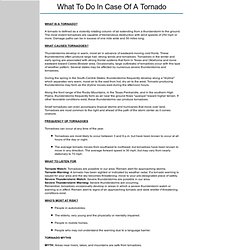
The most violent tornadoes are capable of tremendous destruction with wind speeds of 250 mph or more. Damage paths can be in excess of one mile wide and 50 miles long. Thunderstorms develop in warm, moist air in advance of eastward-moving cold fronts. These thunderstorms often produce large hail, strong winds and tornadoes. Tornadoes in the winter and early spring are associated with strong frontal systems that form in Texas and Oklahoma and move eastward toward Caddo-Bossier area. During the spring in the South-Central States, thunderstorms frequently develop along a "dryline" which separates very warm, moist air to the east from hot, dry air to the west.
Along the front range of the Rocky Mountains, in the Texas Panhandle, and in the southern High Plains, thunderstorms frequently form as air near the ground flows "upslope" toward higher terrain. People in automobiles. The Free Online Encyclopedia of Washington State History. HistoryLink.org Essay 8099 : Printer-Friendly Format At about 12:51 p.m. on April 5, 1972, a severe (category F3) tornado strikes the eastern part of Vancouver, Washington.

The tornado demolishes the Peter Skene Ogden Elementary School, then sweeps through the Sunrise Bowling Lanes and the Waremart Discount Store. Six people are killed and over 300 are injured. Property damage exceeds $5 million. Squall Lines Form On Wednesday morning, April 5, 1972, cold air began moving inland from the Pacific Ocean and collided with warm air in Oregon’s Willamette Valley and the coastal mountains. The storm continued to intensify as it moved north through Portland, and just before 12:50 p.m., observers on the ground just south of the Columbia River noted a sudden and dramatic increase in the winds.
Vancouver Is Hit. Weather Wiz Kids weather information for kids. Tornadoes What is a tornado?
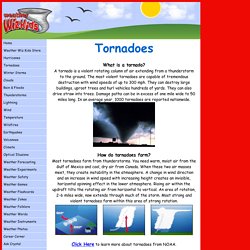
A tornado is a violent rotating column of air extending from a thunderstorm to the ground. The most violent tornadoes are capable of tremendous destruction with wind speeds of up to 300 mph. They can destroy large buildings, uproot trees and hurl vehicles hundreds of yards. They can also drive straw into trees. Damage paths can be in excess of one mile wide to 50 miles long.
Tornado. A tornado is a violently rotating column of air that is in contact with both the surface of the earth and a cumulonimbus cloud or, in rare cases, the base of a cumulus cloud.
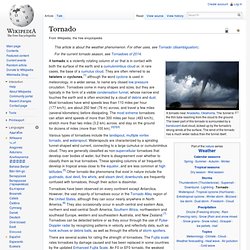
They are often referred to as twisters or cyclones,[1] although the word cyclone is used in meteorology, in a wider sense, to name any closed low pressure circulation. Tornadoes come in many shapes and sizes, but they are typically in the form of a visible condensation funnel, whose narrow end touches the earth and is often encircled by a cloud of debris and dust. Most tornadoes have wind speeds less than 110 miles per hour (177 km/h), are about 250 feet (76 m) across, and travel a few miles (several kilometers) before dissipating. The most extreme tornadoes can attain wind speeds of more than 300 miles per hour (483 km/h), stretch more than two miles (3.2 km) across, and stay on the ground for dozens of miles (more than 100 km).[2][3][4] Tornadoes have been observed on every continent except Antarctica. Google Image Result for. Top 10 Biggest Tornadoes. HIGH DEFINITION HUGE MANITOBA TORNADO! June 23, 2007 - VIDEO INSIDE A TORNADO!!! Aurora, NE Tornado, June 17, 2009.
Colossal Canadian tornado! Ken Weathers - Tornado Formation Explanation. How Tornadoes Form. Tornadoes....Nature's Most Violent Storms. Step into the wild world of weather!

What is a wall cloud? What's the difference between a watch and a warning? Is it ever “too cold to snow”? Learn all about thunderstorms, tornadoes, hail, lightning, floods, damaging winds and severe winter weather. Thunderstorms There can be as many as 40,000 thunderstorms each day around the world. Learn more → Tornadoes. Tornado. Tornado-1.jpg (400×300) Tornado-in-monument-valley.jpg (400×300) How Do Tornadoes Form. Want to stay on top of all the space news?

Follow @universetoday on Twitter Tornado in Kansas How do tornadoes form? That is pretty easy to answer since there has been a large amount of study into the subject. Biggest Tornado. Want to stay on top of all the space news?
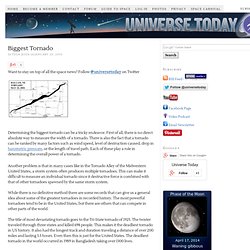
Follow @universetoday on Twitter. Dangerous Weather. Tornadoes are associated with large (supercell) thunderstorms that often grow to over 40,000 feet.
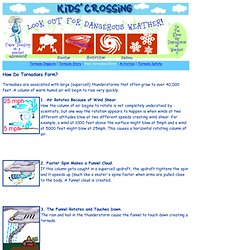
A column of warm humid air will begin to rise very quickly. 1. Air Rotates Because of Wind Shear. How the column of air begins to rotate is not completely understood by scientists, but one way the rotation appears to happen is when winds at two different altitudes blow at two different speeds creating wind shear. For example, a wind at 1000 feet above the surface might blow at 5mph and a wind at 5000 feet might blow at 25mph. 2.